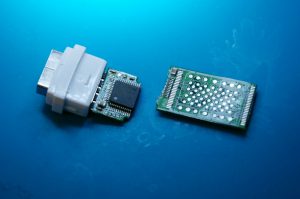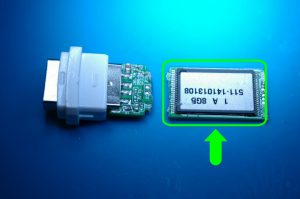There are all kinds of ways to accidentally break a USB drive – accidents happen, and these little devices can be fragile. When they take a bad hit, the most common damage is just a detached USB connector, and if you’re going to experience a broken flash drive, that’s the way you want it to go (learn more about how to repair a flash drive) but sometimes, it looks a whole lot worse…
 The photo here shows a customer’s flash drive that was sent in for data recovery. It’s not a pretty sight, right? Yes, the printed circuit board (PCB) snapped completely in two, and to make things worse, it took twelve microcontroller pins with it. If you see this happen to your drive, you’ll probably panic! But not so fast, it looks worse than it is. Maybe there’s a possibility that Humpty Dumpty could be put back together again with enough time and careful micro-soldering, but there’s no reason to go through that kind of trouble. Let’s take a look at the other side of the flash drive…
The photo here shows a customer’s flash drive that was sent in for data recovery. It’s not a pretty sight, right? Yes, the printed circuit board (PCB) snapped completely in two, and to make things worse, it took twelve microcontroller pins with it. If you see this happen to your drive, you’ll probably panic! But not so fast, it looks worse than it is. Maybe there’s a possibility that Humpty Dumpty could be put back together again with enough time and careful micro-soldering, but there’s no reason to go through that kind of trouble. Let’s take a look at the other side of the flash drive…
 Look in the highlighted area. That chip with the white label is the memory chip, AKA the NAND, and as long as that is intact, there’s a very good chance to recover the data, even with a broken circuit board. In this case, we matched the patient drive’s controller to a donor in our inventory – a relatively common Phison PS2251-67-5. Then, we carefully de-soldered and removed the NAND chip from the broken flash drive, and transplanted it to the matching donor. Since the NAND chip had no damage, the transplant resulted in a perfect recovery over a standard USB connection, without the need to elevate the case to chip readers and working with data dumps.
Look in the highlighted area. That chip with the white label is the memory chip, AKA the NAND, and as long as that is intact, there’s a very good chance to recover the data, even with a broken circuit board. In this case, we matched the patient drive’s controller to a donor in our inventory – a relatively common Phison PS2251-67-5. Then, we carefully de-soldered and removed the NAND chip from the broken flash drive, and transplanted it to the matching donor. Since the NAND chip had no damage, the transplant resulted in a perfect recovery over a standard USB connection, without the need to elevate the case to chip readers and working with data dumps.
Keep in mind that this process requires the right equipment and technique to avoid putting the data at further risk. (See: How NOT to Repair a Flash Drive) If you have a broken flash drive that needs data recovery, we can help!